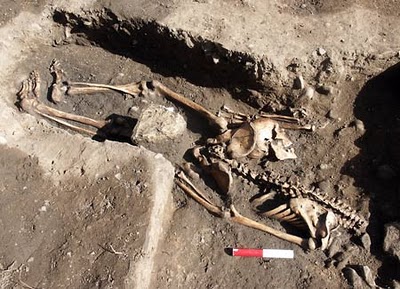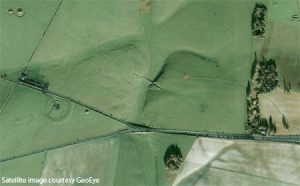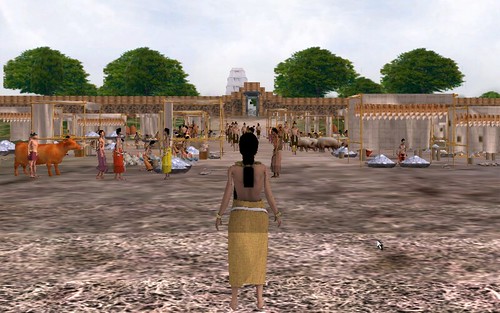 Ever wondered how a 7th century temple complex must have looked like?You can now find out, as the USBerkeley’s Architecture Department has launched what they call a ‘Digital Model of Tangible and Intangible Cultural Heritage’ of one of Cambodia’s earliest Khmer temple complexes. The team used a 3Dgame engine to bring their models of Sambor Prei Kuk alive, allowing you to walk amongst digital reconstructions of ancient ruins – they pre-date Angkor Wat by several centuries – whilst reciting your prayers. Architecture Professor Yehuda Kalay – head of the Virtual Sambor Prei Kuk project – is convinced that this project will make information available to the public that up to now has remained the exclusive province of researchers.
Ever wondered how a 7th century temple complex must have looked like?You can now find out, as the USBerkeley’s Architecture Department has launched what they call a ‘Digital Model of Tangible and Intangible Cultural Heritage’ of one of Cambodia’s earliest Khmer temple complexes. The team used a 3Dgame engine to bring their models of Sambor Prei Kuk alive, allowing you to walk amongst digital reconstructions of ancient ruins – they pre-date Angkor Wat by several centuries – whilst reciting your prayers. Architecture Professor Yehuda Kalay – head of the Virtual Sambor Prei Kuk project – is convinced that this project will make information available to the public that up to now has remained the exclusive province of researchers.
On the project website, Professor Kalay does admit some freedom of interpretation was applied to the build: “It certainly is a technology of illusion, creating an intangible reality. It freely borrows architectural principles, but can only be experienced through the proxy of avatars. Most importantly (and perhaps disturbingly), it requires filling in of missing details – architectural, social, ritualistic, and others – to create a complete experience. Many of these details are based on conjecture and interpretation, informed by thorough research. Therefore, we do not claim absolute historical accuracy: instead, we have tried to provide an experience that will convey, as best we can, the sense of being at Sambor Prei Kuk in the 7th century AD.”
A Closer Look at Virtual Sambor Prei Kuk
I must admit, I could not wait to give Virtual SPKa try!Although I might lack the needed archaeological and historical knowledge to judge the build, I have quite an extensive history in residing in, testing, complaining about and helping to build virtual world environments. Yet, the one I’m most familiar with is our very own King Tut Virtual, which I’m most likely to compare to. These things – positive as well as negative – grabbed my attention, not only because we encounter the same issues and triumphs daily:
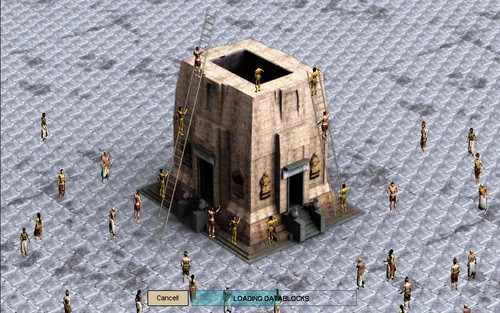 Getting Started – Although it took me according to current web standards quite a while to download the 100mb install file, I made good use of my time by browsing their website and learning some more about Sambor Prei Kuk. The installation itself caused no problems, but a ‘Run Virtual SPK’ now link at the end of the install process would have been handy.
Getting Started – Although it took me according to current web standards quite a while to download the 100mb install file, I made good use of my time by browsing their website and learning some more about Sambor Prei Kuk. The installation itself caused no problems, but a ‘Run Virtual SPK’ now link at the end of the install process would have been handy.
You &Your Avatar – I know I am spoiled with fully customisable avatars, but to be honest, not only the lack of choice – two male and two female avatars, no more ‘dress up’ options later – was disappointing, but also the lack of mesh. People are not square! I must admit though, I certainly fitted in with the rest of the crowd! You can detach your ‘camera’ from your avatar, but not freely move it around. Many great snapshots were not possible due to this restriction. *sobs* (Also because there is no way to ‘permanently claim’ your avatar name as your own.)
Navigation – The keyboard controls option in the program was not working for me, and it took me a while to figure out that I was not supposed to use the standard arrow keys to walk around, but the letter keys Quake-style. Once adjusted to this, it’s not a bad way to make your way to the inner sanctuary, yet it continue to feel uncomfortable.
Things To Do, Interaction &Information – There are quite a bit of ‘game characters’ (NPCs) running around in Virtual Sambor Prei Kuk, making their way to the sanctuary, trying to sell you animals and other products or praying. This – together with good sound integration – definitely adds to the ‘immersionalist’ experience. Your avatar can do certain animations such a praying, waving and jumping, but there is nothing ‘real’ to do. No opening of doors, shoving someone annoying aside or sitting down to join the prayers at the camp fire. And only to often I stood before a virtually recreated ancient building, wondering ‘What was the use?’ or looked at people wondering what they were doing*. Yet, no way to retrieve more information from in-world? Here there definitely is still room for improvement.
(* Those chickens and pigs, were they food or for ritual sacrifice?)
Fellow Visitors – Virtual SPK offers you the choice to either ‘visit alone’ or ‘in group’. The ‘in group’ did not seem to work for me – yes, I did click it a few times and waited more than patiently – so I didn’t ran into anyone to test the ‘chat’ with.
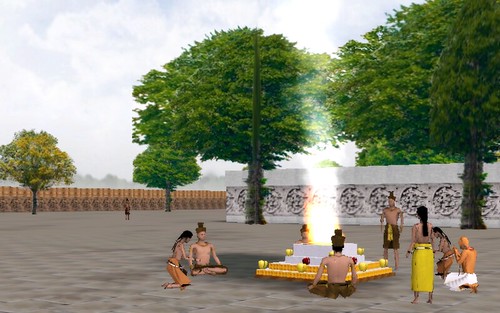 Build Quality – Although the dead, processed poultry is pretty convincing – and constructed out of primitives (virtual building blocks) – the ‘live’ chickens and pigs were besides their natural sounds a bit flat. They are just 2D textures, and at most angles, look horrible. The builds itself are solid and better detailed, yet they could do with a few cracks – and baked shadows – here and there. The terrain map used suffers from the same problem as the chicken: lack of depth.
Build Quality – Although the dead, processed poultry is pretty convincing – and constructed out of primitives (virtual building blocks) – the ‘live’ chickens and pigs were besides their natural sounds a bit flat. They are just 2D textures, and at most angles, look horrible. The builds itself are solid and better detailed, yet they could do with a few cracks – and baked shadows – here and there. The terrain map used suffers from the same problem as the chicken: lack of depth.
Game Engine &Graphics – I’m sure with the mesh available, my graphics card could render less graphics with less aliasing occurring than I got now, even at high resolution. It would be nice to have some options available – low performance/high graphics quality, medium of both or high performance/low graphics quality – for those who don’t mind waiting a bit or have top notch machines. Assuming the university used the basic version of the Torque 3Dengine, most likely though features such as use of depth of field and advanced lighting were not included. Maybe for Virtual SPK 2.0?
Overall – and despite my list of ‘things that could have been better’ above – I think Virtual Sambor Prei Kuk is a great example of how virtual worlds can be used to make History and Archaeology more accessible! They have created an easy accessible virtual experience with lots of background information available through their project website, and definitely a step further in ‘digital reconstructions’ than Digital Karnak or Ancient Rome 3D. I’d definitely suggest you’d give it a try! What do you think?Are my comments to harsh?
Other ‘virtual’ projects you could also be interested in are Virtual Qumran – not yet accessible to avatars – and our very own King Tut VX.
Hat tip to the Southeast Asian Archaeology Newsblog for bringing this to my attention!

